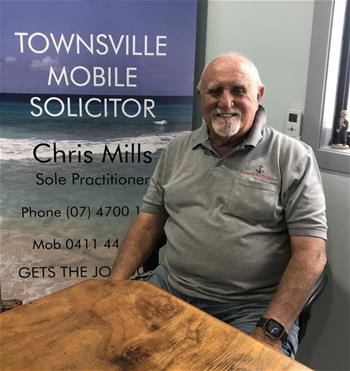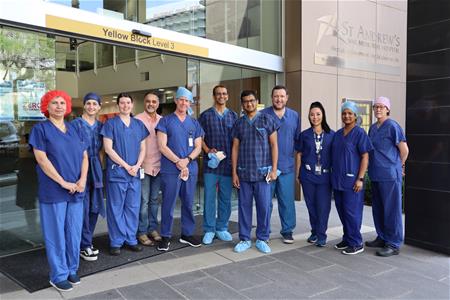A new heart procedure performed for the first time on the east coast of Australia at St Andrew’s War Memorial Hospital is delivering exceptional outcomes for patients with long-standing persistent atrial fibrillation, a type of abnormal heart rhythm which can cause the heart to beat irregularly and fast.
Christopher Mills, an active 75-year-old father and grandfather from Townsville, was one of the first to benefit from the procedure which has already led to the reversal of heart failure caused by the condition.
Chris, a former naval officer of 35 years and practicing solicitor, was diagnosed with atrial fibrillation after a heart attack in 2019.
 “I was tired and irritable, I had vertigo and nausea every day. That’s when I was referred to see Dr Tomos Walters in Brisbane. Dr Walters told me my heart function was at 22 per cent, and normal function is around 60 per cent,” Chris said.
“I was tired and irritable, I had vertigo and nausea every day. That’s when I was referred to see Dr Tomos Walters in Brisbane. Dr Walters told me my heart function was at 22 per cent, and normal function is around 60 per cent,” Chris said.
Chris underwent a cardioversion procedure, which is used for the treatment of atrial fibrillation and involves delivery of a controlled electric shock to restore regular heart rhythm. He remained in sinus rhythm, or normal rhythm, for the next year.
“I was going along merrily and then I fell out of sinus rhythm and was feeling unwell again. I was really unhappy, so I went back to see Dr Walters and that’s when he offered me the option of trying a new procedure,” Chris said.
“We looked at all the information about the new procedure, and Dr Walters explained why it would be suitable for me. He explained the remarkable results achieved in the United States and in Perth, and I said I’m in.”
Known as the Convergent procedure, the treatment combines two different types of ablation, surgical and catheter, provided in two stages about three months apart to treat both inside and outside the heart.
Cardiac ablation is a common treatment for arrythmia and uses energy to create lesions on the heart in an effort to block the erratic electrical signals which cause atrial fibrillation.
The procedure is a convergence of techniques which complement each other to provide a more effective outcome, and is being made possible for patients at St Andrew’s by electrophysiologist cardiologist, Dr Tomos Walters, and cardiothoracic surgeon, Dr Rishendran Naidoo, and their multi-disciplinary team.
 Dr Walters said the Convergent procedure is targeted at patients with long-standing persistent atrial fibrillation which has continued for a year or longer.
Dr Walters said the Convergent procedure is targeted at patients with long-standing persistent atrial fibrillation which has continued for a year or longer.
“Now, with the Convergent procedure we have something to offer patients with long-standing atrial fibrillation. It’s opened up a cohort of patients who can benefit from advanced rhythm control and we’re really excited about that,” Dr Walters said.
“When a patient has atrial fibrillation, we’re interested in helping in a few ways. Our focus is on improving quality of life for our patients, improving symptoms, minimising risk of stroke, protecting heart function or improving heart function if atrial fibrillation has affected it.
“We do that with a combination of blood thinning medications, anti-arrhythmic medications and catheter-ablation to suppress atrial fibrillation. Patients who benefit most and respond best to these treatments are those who have relatively early disease.
“In this new procedure we are not doing anything radically different, the key difference and what makes it more effective for long-standing atrial fibrillation, is the combination of the surgical procedure and catheter procedure, and there is good evidence to support this,” Dr Walters said.
Chris Mills successfully underwent the first stage of the Convergent procedure, a minimally invasive procedure provided by cardiothoracic surgeon, Dr Rishendran Naidoo, in October 2022.
“This procedure offers a surgical option which is less invasive when combined with the interventional cardiology catheter-ablation approach as well,” Dr Naidoo said.
“The first stage involves a small incision to access the back wall of the left atrium of the heart. First, we ablate the back wall of the left atrium, before we insert a device known as the Atriclip.
“The Atriclip is used to reduce clot formation in the left atrial appendage – a small pouch which is found in the top left of the heart – which is a risk for patients with atrial fibrillation,” Dr Naidoo said.
In January 2023, Chris underwent his second procedure, a catheter-ablation with Dr Tomos Walters.
“The outcomes for Chris have been really good. Chris was symptomatic and he’d developed heart failure as a result of atrial fibrillation. When the heart is failing, it means it’s becoming weak and not pumping blood efficiently and this contributes to the symptoms the patient feels,” Dr Walters said.
“Since the procedure and being back in normal rhythm, Chris’ heart failure has been reversed already.”
For Chris, the Convergent procedure has not only improved his symptoms, but it’s helping him get back to normal life and everything he enjoys.
“With atrial fibrillation, I felt extreme tiredness, it’s exhaustion. You’re dragging yourself around and your heart is pumping like crazy. To do anything is exhausting and it’s really noticeable,” Chris said.
“Now that my heart function has improved and I’m in normal rhythm, it also means that I can now be considered for another procedure I need for my hip, which would have been too risky before. With that complete, I’ll really be able to get back to my normal active lifestyle.
“I’m very happy that I had the procedure. I look forward to staying in normal rhythm, if I can do that, my life will be good,” Chris said.
The Convergent procedure is available to patients from across Queensland and beyond at St Andrew’s War Memorial Hospital in collaboration with our partners at AtriCure. To learn more about the procedure, please visit the Convergent Atrial Fibrillation Institute.